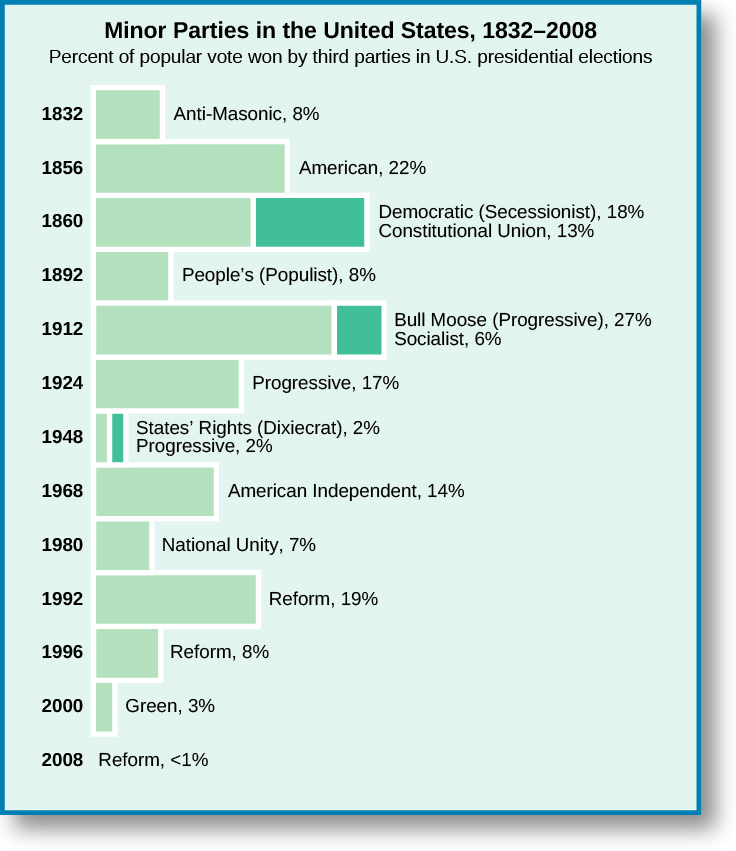| << Chapter < Page | Chapter >> Page > |

In 1912, former Republican president Theodore
Roosevelt attempted to form a third party, known as the
Progressive Party , as an alternative to the more business-minded Republicans. The Progressives sought to correct the many problems that had arisen as the United States transformed itself from a rural, agricultural nation into an increasingly urbanized, industrialized country dominated by big business interests. Among the reforms that the Progressive Party called for in its 1912 platform were women’s suffrage, an eight-hour workday, and workers’ compensation. The party also favored some of the same reforms as the Populist Party, such as the direct election of U.S. senators and an income tax, although Populists tended to be farmers while the Progressives were from the middle class. In general, Progressives sought to make government more responsive to the will of the people and to end political corruption in government. They wished to break the power of party bosses and political machines, and called upon states to pass laws allowing voters to vote directly on proposed legislation, propose new laws, and recall from office incompetent or corrupt elected officials. The Progressive Party largely disappeared after 1916, and most members returned to the Republican Party.
In 1948, two new third parties appeared on the political scene. Henry A.
Wallace , a vice president under Franklin Roosevelt, formed a new Progressive Party, which had little in common with the earlier Progressive Party. Wallace favored racial desegregation and believed that the United States should have closer ties to the Soviet Union. Wallace’s campaign was a failure, largely because most people believed his policies, including national healthcare, were too much like those of communism, and this party also vanished. The other third party, the States’ Rights Democrats, also known as the
Dixiecrats , were white, southern Democrats who split from the Democratic Party when Harry
Truman , who favored civil rights for African Americans, became the party’s nominee for president. The Dixiecrats opposed all attempts by the federal government to end segregation, extend voting rights, prohibit discrimination in employment, or otherwise promote social equality among races.
None of these alternatives to the two major political parties had much success at the national level, and most are no longer viable parties. All faced the same fate. Formed by charismatic leaders, each championed a relatively narrow set of causes and failed to gain broad support among the electorate. Once their leaders had been defeated or discredited, the party structures that were built to contest elections collapsed. And within a few years, most of their supporters were eventually pulled back into one of the existing parties. To be sure, some of these parties had an electoral impact. For example, the Progressive Party pulled enough votes away from the Republicans to hand the 1912 election to the Democrats. Thus, the third-party rival’s principal accomplishment was helping its least-preferred major party win, usually at the short-term expense of the very issue it championed. In the long run, however, many third parties have brought important issues to the attention of the major parties, which then incorporated these issues into their platforms. Understanding why this is the case is an important next step in learning about the issues and strategies of the modern Republican and Democratic parties. In the next section, we look at why the United States has historically been dominated by only two political parties.
Political parties are vital to the operation of any democracy. Early U.S. political parties were formed by national elites who disagreed over how to divide power between the national and state governments. The system we have today, divided between Republicans and Democrats, had consolidated by 1860. A number of minor parties have attempted to challenge the status quo, but they have largely failed to gain traction despite having an occasional impact on the national political scene.

Notification Switch
Would you like to follow the 'American government' conversation and receive update notifications?